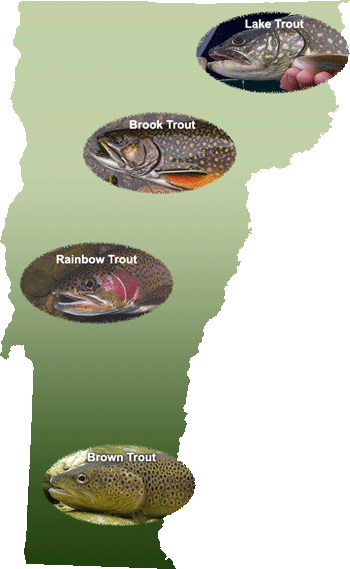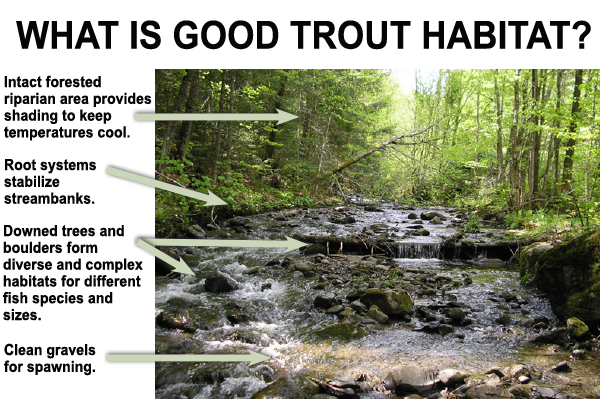The department's wild trout management focuses on protecting and enhancing water quality and aquatic habitats.
Vermont's Wild Trout

Vermont is fortunate to have a wealth of wild trout populations. They are indicators of a healthy environment, needing cold, clean water and complex and connected habitats.
- Brook Trout - are abundant in Vermont's many upland streams and some of the Northeast Kingdom's coldwater ponds.
- Brown Trout - inhabit the larger coldwater streams and rivers and their tributaries, such as the Batten Kill.
- Rainbow Trout - inhabit the larger coldwater streams and rivers and their tributaries, such as the Dog River.
- Lake Trout - favor the coldwater lakes in the Northeast Kingdom.
Vermont's Wild Trout Management Strategies
Environmental Review
Fisheries staff expended hundreds of hours each year protecting aquatic habits through project review and interagency coordination on aquatic habitat issues, such as Act 250, Section 248, Stream Alteration, Dam Safety, hydroelectric relicensing, and water withdrawals.
Monitoring Wild Trout Populations
Fisheries biologists conduct long-term monitoring of wild trout populations to evaluate population health and determine appropriate management strategies, such as fishing regulations and habitat enhancements.
Fishing Regulations
Special fishing regulations may be necessary to protect spawning concentrations of wild trout or limit angler harvest to maintain suitable population levels.
Streambank (Riparian) Enhancement
Restoring and protecting forested areas along streams and rivers (known as riparian areas) is the most effective strategy for improving and maintaining wild trout habitats over the long term. Mature trees along stream banks provide shade to the stream and keep water temperatures low. Over time, some of these trees will fall into the stream, and create important habitat for trout and other species.
Aquatic Habitat Enhancement
Department fisheries biologists sampled and monitored 33 streams in northeastern Vermont to determine what factors make for a good brook trout stream. The study indicated water temperature and the amount of wood per acre were the best predictors of brook trout abundance.
Based on this study, biologists are deliberately adding natural wood to selected streams where these important habitats features are lacking, and monitoring these streams to determine if this practice can effectively improve trout populations. The results are promising.
Wood is Good for Brook Trout - An article about the results of the work to improve trout habitat by adding wood to streams in the Northeast Kingdom.
Aquatic Organism Passage (AOP) Enhancements
The ability for fish and other organisms to move up and down streams to access a wide range of habitats is critical for their long-term survival. Recent assessment of road/stream crossings in Vermont found only five percent provided unhindered fish passage.
Vermont Fish & Wildlife staff are working collaboratively with the Vermont Department of Environmental Conservation, VTrans and many others to improve fish passage in Vermont. These efforts include:
- Developing and implementing technical design guidelines for road/stream crossings.
- Producing a laymen's guidebook, the Vermont Stream Crossing Handbook.
- Coordinating with private and governmental partner organizations to improve aquatic passage at dams and culverts.
- Follow-up evaluations of fish passage.
- Providing partial funding for aquatic organism passage projects.

